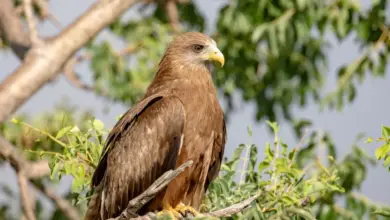Short-tailed Nighthawk
The Short-tailed Nighthawk (Lurocalis semitorquatus) – also known as the Semi-collared Nighthawk – occurs naturally in Central and South America.
This nightjar is commonly heard within its range, but less often seen – due to its nocturnal habits. Its brown-mottled plumage keeps it well camouflaged during the day when it is also usually hidden away from sleeping.
Alternate (Global) Names:
Chinese: ???? … Czech: lelek límcový … Danish: Korthalet Nathøg … German: Bändernachtschwalbe … French: Engoulevent à queue courte … Italian: Caprimulgo-sparviero dal semicollare, Succiacapre codacorta … Japanese: tanbiyotaka … Dutch: Kortstaartnachtzwaluw … Norwegian: Dunkelnatthauk … Polish: lelczyk krótkosterny … Portuguese: bacurau, curiango-coleira, Tuju … Russian: ??????????????? ??????? … Slovak: Lelek kolohrivý, súmracník kolohrivý … Spanish: Añapero castaño, Añapero Colicorto, Atajacaminos castaño, Chotacabra de Cola Corta, Chotacabras cola corta, Chotacabras Colicorta, Chotacabras Rabicorto, Pucuyo colicorto … Swedish: Kortstjärtad falknattskärra
Distribution / Range
The short-tailed Nighthawk is endemic to the following countries:
Central America:
Mexico, Guatemala, Honduras, Nicaragua, Costa Rica, Panama
South America:
Ecuador, Colombia, Venezuela, islands of Trinidad and Tobago, Guyana, Suriname, French Guiana, Brazil, Peru, Bolivia, Brazil, Paraguay, Argentina
Habitat:
Short-tailed Nighthawks inhabit subtropical or tropical moist lowland forests and swamps.
Recognized Subspecies and Ranges
- Lurocalis semitorquatus semitorquatus (J. F. Gmelin, 1789) – Nominate Race
- Range: Northeastern Colombia and west and south Venezuela east through the Guianas, and extreme western Brazil. May also occur on the islands of Trinidad and Tobago – but subspecies status requires verification.
- Lurocalis semitorquatus stonei (Huber, 1923)
- Range: Southeastern Mexico south through northeastern Guatemala and northern Honduras to northeastern Nicaragua.
- Lurocalis semitorquatus noctivagus (Griswold, 1936)
- Range: Costa Rica and Panama south to coastal west Colombia and northwestern Ecuador.
- Lurocalis semitorquatus schaeferi (Phelps and Phelps, Jr., 1952)
- Range: Northern Venezuela.
- Natterer’s Nighthawk ((Lurocalis semitorquatus nattereri) (Temminck, 1822)
- Often considered a separate species
- Range: East Ecuador, north and eastern Peru and Brazil (south of the Amazon Basin) south to northern Argentina
Description
They are medium-sized nocturnal birds with long pointed wings and very short bills. They have short legs and small feet, of little use for walking. Their soft plumage is cryptically colored to resemble bark or leaves.
Their cryptic appearance enables them to blend perfectly into their habitat and they are very difficult to see during the daytime when they are usually hidden away sleeping. These birds are most easily detected at night when light from car headlights is reflected red from their eyes, as they are sitting on tracks or roads. However, their presence is more likely made known by their loud calls given at dusk.
Nesting / Breeding
The male establishes his territory and sings at night to keep rivals away and at the same time to attract a female.
Short-tailed Nighthawks don’t construct a nest, as most other bird species do. They simply place the eggs on the ground on open soil covered with dead leaves.
Nesting appears to be timed in such a way that the moon is more than half full at the time they are feeding their young – likely as the additional light during the night facilitates caring for the young and foraging for food.
The female may lay one to two eggs (mostly two) that are whitish or creamy, with brown and grey spots or blotches.
During the day, the incubation of the eggs is undertaken by the female, while both parents share the incubation at night. The incubation period is about 19 to 21 days. The chicks emerge covered in down. They are capable of short-distance movements within 24 hours of hatching. The male guards and defends the nest and the young. He will hover in place near the nest with his body in a nearly vertical position. The adults communicate with their young via soft clucking sounds to which the chicks respond.
The parents feed the young regurgitated food (insects), and they continue to brood them until they fledge. The young take their first flight when they are about 20 to 21 days old.
If conditions are favorable, the female may lay a second clutch close to the first and while she is incubating the new set of eggs, the male continues to care for the young from the first brood.
They have developed several behavioral adaptations to minimize predation:
- Their nocturnal (night) lifestyle reduces the likelihood of being detected by daytime predators. During the daytime, they typically sleep on the ground where they are perfectly camouflaged by their “earthy” colored plumage. They almost always change their roost sites daily.
- When nesting, they sit quietly on the eggs, minimizing any movements that could get them detected.
- If an intruder does get close to the nest, the parents may try to lead them away by first flushing off the nest and when landing feigning injury as they lead the potential thread away from the nest. While the parent performs this distraction display, the young may scatter and freeze.
- The parent who is not incubating the eggs or brooding the young will roost away from the nesting area.
- They may also move the eggs or young to prevent them from being preyed upon.
- Nightjars avoid voicing when they hear the calls made by predatory nocturnal animals, such as owls.



